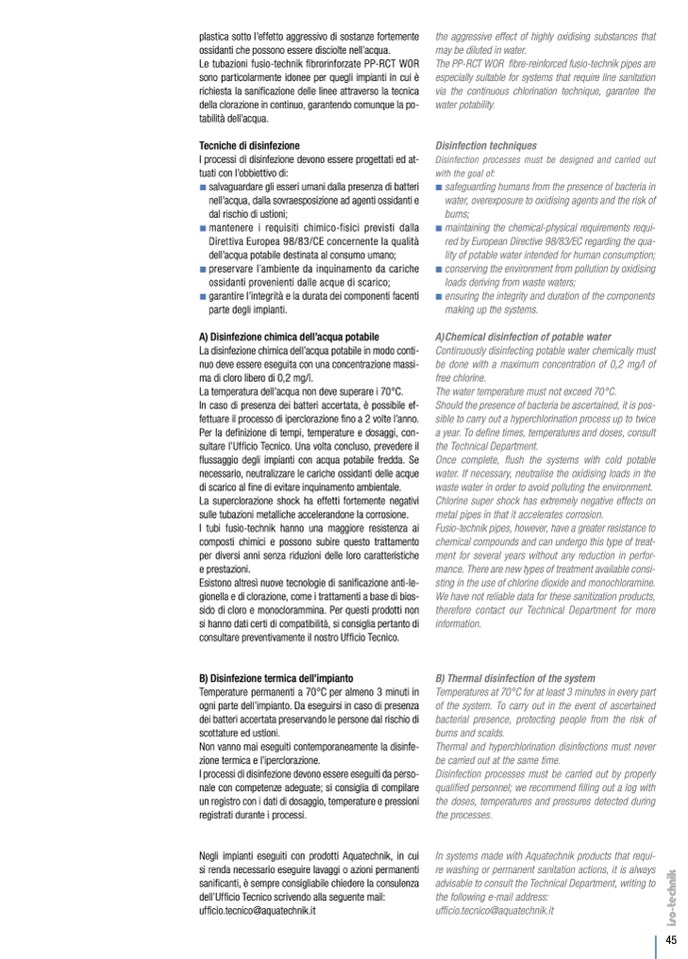


1) Collaudo finale dell’impiant ,
indicazioni generali
1) Final system testing,
general instructions
Ogni impianto realizzato -idrico sanitario, riscaldamento
o di altro genere- dovrà essere collaudato dall’azienda
installatrice in conformità alla legislazione o alle norme
vigenti. Il collaudo prevede una serie di verifiche da effet-
tuare in corso d’opera o ad impianto ultimato prima della
muratura o rinterro definitivi: l’esito positivo di queste ve-
rifiche determina l’accettabilità dell’impianto.
Il Decreto del Ministero dei Lavori Pubblici del 12/12/1985
prevede che: “La prova di collaudo in campo per pres-
sione interna saggia l’opera condottuale al termine delle
diverse operazioni di costruzione, trasporto e posa in ope-
re-giunzione: essa rappresenta la verifica finale dell’opera
di significato globale per le diverse operazioni. La pres-
sione minima di collaudo viene fissata in un valore unico
per tutte le differenti tipologie di tubazioni correlato con la
pressione di esercizio (pe) salva la possibilità del proget-
tista di precisare maggiori valori nel Capitolato Speciale di
Appalto in considerazione delle finalità dell’opera”.
Pertanto, in conseguenza delle facoltà e delle responsa-
bilità a cui è richiamato il progettista nel definire le condi-
zioni di collaudo, si ritiene che in funzione della tipologia di
impianto, della dimensione e lunghezza della rete, spetti al
progettista stesso definire le modalità del collaudo.
Vengono indicati a titolo esemplificativo alcuni metodi di
collaudo:
UNI EN 806-4 - Decreto del Ministero dei Lavori Pub-
blici del 12/12/1985 - UNI EN 805 - UNI 11149 - DIN
1988 - UNI EN 13941.
La UNI EN 805: 2002 definisce due metodi:
n della perdita di pressione;
n della perdita d’acqua.
Di seguito viene illustrato il metodo di collaudo secondo
la UNI EN 806-4 procedura C modificato secondo sugge-
rimenti Aquatechnik. Resta comunque responsabilità del
progettista definire queste condizioni.
La prova può essere eseguita con acqua. Dove ammesso
dalla regolamentazioni nazionali, è consentito l’uso di
aria a bassa pressione senza olio o gas inerti.
I manometri devono avere accuratezza fino a 0,2 bar e
devono essere montati nel punto più basso del sistema.
La normativa UNI EN 806-4 prevede differenti procedure.
Aquatechnik sulla base della trentennale esperienza,
suggerisce di eseguire il collaudo dell’impianto come
previsto dalla normativa UNI EN 806-4 (procedura C)
applicando però una pressione di 15 bar.
Every system installed - sanitary and water supply, he-
ating or other - must be tested by the installing com-
pany in compliance with the laws or standards in force
The testing process involves a series of tests to be carried
out during installation or when the system is completed,
prior to masonry work or backfilling: the acceptability of the
system is subject to the tests being passed successfully.
The Italian Decree of the Ministry of Public Works da-
ted 12/12/1985 states that: “The field acceptance test
for internal pressure tests the conduits at the end of the
various construction, transport, installation and junction
operations: it represents the final inspection of the work,
with global significance for the different operations.
The minimum testing pressure is set at a single value
for all different types of piping related to the operating
pressure (pe), subject to the possibility of the design
engineer specifying higher values in the Special Tender
Specifications, considering the purpose of the work”.
Therefore, as a result of the rights and responsibilities
assigned to the design engineer in defining the test con-
ditions, it is believed that, depending on the type of sy-
stem, the size and the length of the network, it is up to the
design engineer to define the acceptance test methods.
Acceptance test methods are given by way of example
below:
UNI EN 806-4 - Italian Decree of the Ministry of Public
Works dated 12/12/1985 - UNI EN 805 -UNI 11149 - DIN
1988 - UNI EN 13941.
UNI EN 805: 2002 defines two methods:
n for pressure drops;
n for water leakage.
Below illustrates the acceptance test method in complian-
ce with UNI EN 806-4 procedure C, modified according
to Aquatechnik suggestions. It is in any case the respon-
sibility of the design engineer to define these conditions.
The test can be carried out with water. Where permitted by
national regulations, use of low pressure air without oil or
inert gases is allowed.
The pressure gauges must be accurate to 0,2 bar and
must be mounted at the lowest point of the system.
Standard UNI EN 806-4 provides for different procedures.
Aquatechnik, based on thirty years of experience, sugge-
sts that the system is tested as required by Standard UNI
EN 806-4 (procedure C) but applying a pressure of 15 bar.
2) Collaudo dell’impianto secondo
UNI EN 806-4 “Specifi he relative
agli impianti all’interno di edifici
per il convogliamento di acque
destinate al consumo umano”
2) System testing according to
UNI EN 806-4 “Specifications
for plants in buildings for the
conveyance of water intended for
human consumption”
46



